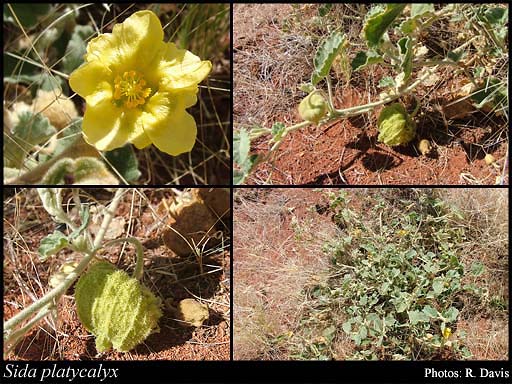- Reference
- Fl.Austral. 1:197 (1863)
- Conservation Code
- Not threatened
- Naturalised Status
- Native to Western Australia
- Name Status
- Current
Diffuse or ascending annual, herb or shrub, to 0.3 m high. Fl. yellow, Mar to Apr or Sep to Oct. Red sand, clay loam. Stony flats, claypans.







Scientific Description
Herb or shrub, with hairy stems. Leaves 25-65 mm long, 17-80 mm wide, not lobed; margins serrate; hairy, with stellate hairswith scales absent, Sessile glands absent; stipules present and persistent to older leaves, 10-20 mm long. Perianth clearly of two whorls (calyx and corolla), the corolla obvious and prominent. Pedicel present, 20-30 mm long; indumentum present, with stellate hairs present, with scales absent. Epicalyx (extra segments or 'bracteoles' immediately below the calyx) absent. Calyx green, 10-14 mm long, the lobes fused half or more of their length, Sessile glands absent, simple hairs (without tubercle bases) absent, stellate hairs present, tubercle-based simple hairs absent, gland-tipped hairs absent, scales absent, Terminal appendages absent, number of ribs absent. Corolla yellow, 15-20 mm long, glabrous. Indumentum (outside) Sessile glands absent. Stamens many, united and arising from a staminal tube around the style; filaments present, 1-1.2 mm long; anthers 0.5-0.6 mm long, indumentum absent (anthers glabrous). Staminodes absent, appendages absent. Ovary hairs and scales absent (ovary quite glabrous); style 1, 5-6 mm long, with four or numerous style branches or lobes, mostly glabrous, wing absent. Fruits indehiscent and splitting into sections (schizocarps), length-width ratio more or less as long as wide, mericarps wrinkled, hairs or scales present, simple hairs (without tubercle bases) absent, stellate hairs present, Sessile glands absent, tubercle-based simple hairs absent, gland-tipped hairs absent, scales absent; apex rounded; prickles absent (except perhaps a terminal awn); terminal awns or spines absent; calyx persistent to mature fruit, 14-15 mm long, accrescent. Flowering time March, April, September or October. Distribution Botanical Province Eremaean, IBRA Bioregion Great Sandy Desert, Tanami, Pilbara, Carnarvon, Gascoyne, Little Sandy Desert, Gibson Desert, Central Ranges and Murchison.
Distribution
- IBRA Regions
- Carnarvon, Central Ranges, Gascoyne, Gibson Desert, Great Sandy Desert, Little Sandy Desert, Murchison, Ord Victoria Plain, Pilbara, Tanami.
- IBRA Subregions
- Ashburton, Augustus, Cape Range, Carnegie, Chichester, Eastern Murchison, Fortescue, Hamersley, Lateritic Plain, Mackay, Mann-Musgrave Block, McLarty, Rudall, South Kimberley Interzone, Tanami Desert, Trainor, Western Murchison, Wooramel.
- Local Government Areas (LGAs)
- Ashburton, Carnarvon, East Pilbara, Halls Creek, Meekatharra, Ngaanyatjarraku, Upper Gascoyne, Wiluna.